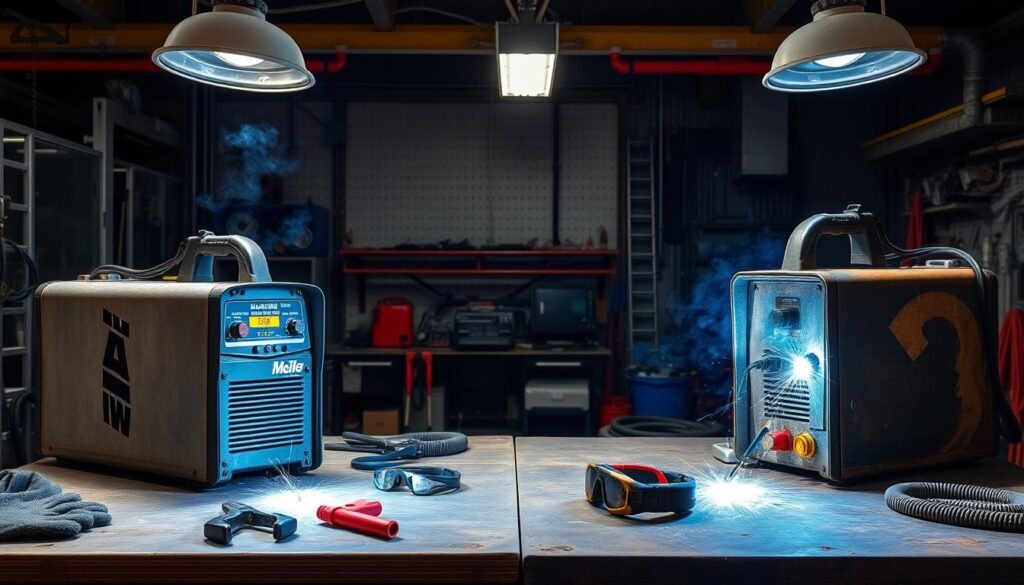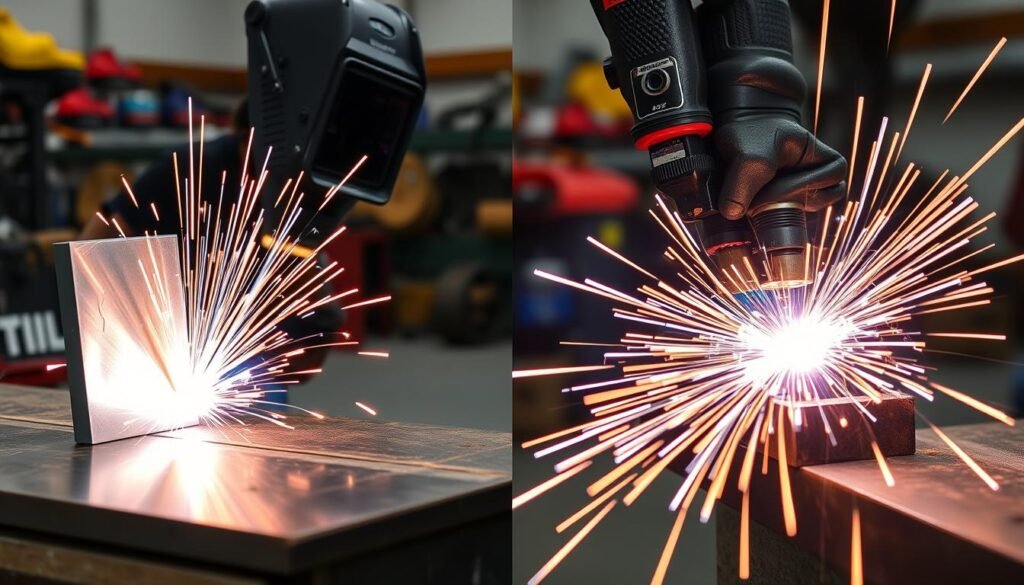Metal welding is a key part of making things, but it’s harder with different materials like aluminum and steel. Skilled welders know each metal needs its own special ways and deep knowledge of its properties to get the best results.
Welding aluminum and steel needs different methods because of their different heat conductivities, melting points, and structures. The welding techniques must fit each material’s needs to make sure the join is strong and works well.
It’s important for engineers, fabricators, and metalworkers to know the main differences in welding aluminum and steel. This knowledge helps them use the right joining methods for precise and reliable results.
Key Takeaways
- Aluminum and steel have distinct welding challenges
- Material properties significantly impact welding techniques
- Thermal conductivity varies between different metals
- Specialized equipment is required for each material
- Comprehensive knowledge ensures successful metal welding
Introduction to Metal Welding Fundamentals
Welding is a key manufacturing process. It turns raw materials into complex structures through metal fusion. Knowing the basics of welding helps make strong connections between metals.
Welding is both an art and a science. It requires a mix of scientific knowledge and practical skills. Welders need to understand complex welding principles to join metals successfully.
Basic Principles of Metal Fusion
Metal fusion involves several important interactions:
- Precise temperature control for optimal material transformation
- Understanding unique material properties of different metals
- Selecting appropriate welding techniques based on specific requirements
Understanding Material Properties
Every metal has its own special traits that affect welding. Important properties include:
| Property | Impact on Welding |
|---|---|
| Thermal Conductivity | Determines heat distribution during welding |
| Melting Point | Defines required energy for metal fusion |
| Metallurgical Structure | Influences weld strength and durability |
Role of Temperature Control
Temperature control is crucial in welding. Precise heat application ensures optimal metal fusion without compromising material integrity.
“Mastering temperature control is the cornerstone of exceptional welding craftsmanship.” – Professional Welding Association
Welding experts must learn to manage heat well. This protects the material while creating strong connections.
Material Characteristics: Aluminum vs Steel
It’s key to know the special traits of aluminum and steel for good welding. These metals have different qualities that affect how they weld and perform.
Aluminum and steel are different in many ways. Aluminum is light and conducts heat well. Steel is strong and lasts longer.
- Aluminum thermal conductivity: Approximately 237 W/mK
- Steel thermal conductivity: Around 50 W/mK
- Aluminum melting point: 660°C (1220°F)
- Steel melting point: 1370°C (2500°F)
“Understanding material properties is the foundation of effective welding techniques.” – Welding Engineering Experts
Aluminum and steel face different welding challenges. Aluminum’s low melting point and high heat conductance need special methods. This helps avoid warping and ensures good joining.
| Property | Aluminum | Steel |
|---|---|---|
| Density | 2.7 g/cm³ | 7.85 g/cm³ |
| Strength-to-Weight Ratio | High | Very High |
| Corrosion Resistance | Excellent | Moderate |
Welding experts must think about these properties to pick the right methods and tools for each metal.
How Does Welding With Aluminum Differ From Welding With Steel
Welding aluminum and steel is different and needs special skills and methods. Knowing the main differences between these metals is key for making good welds in many industries.
Thermal Conductivity Variations
Aluminum and steel have different heat conductivities. This affects how they are welded. Aluminum heats up faster, making welding it more challenging.
Welders must adjust their methods to avoid warping or distortion. This is because aluminum spreads heat quickly.
- Aluminum conducts heat approximately 5 times faster than steel
- Welders must use lower heat inputs for aluminum welding
- Specialized cooling techniques are often necessary
Oxide Layer Considerations
Dealing with aluminum’s oxide layer is a big challenge. Unlike steel, aluminum has a thick, protective oxide. This layer must be cleaned well before welding.
This oxide layer has a high melting point. It makes welding aluminum very complicated.
“The oxide layer in aluminum welding is like an uninvited guest that complicates the entire process.” – Welding Professional
Strength and Durability Factors
Weld strength is different for aluminum and steel. Steel is generally stronger. But, aluminum needs careful technique to match steel’s strength.
The choice of thermal treatment and filler materials is also important. They affect the weld’s durability.
| Characteristic | Aluminum Welding | Steel Welding |
|---|---|---|
| Average Weld Strength | 60-70% of base metal | 80-90% of base metal |
| Typical Filler Material | 4043 or 5356 alloy | ER70S-6 |
Welders need to adjust their methods for each material. This ensures the best results for both aluminum and steel.
Essential Equipment and Tools for Each Material
Choosing the right welding equipment is key for successful projects with aluminum and steel. Each material needs its own tools for the best results. Knowing what each metal requires helps welders pick the right machines and accessories.

Aluminum welding tools need special care because of its unique properties. Welders must use precise equipment that can handle its low melting point and high heat transfer.
- TIG welders with advanced temperature control
- Specialized aluminum filler rods
- High-frequency AC power sources
- Argon shielding gas systems
Steel welding tools, on the other hand, need strong and flexible welding machines. These machines must handle high temperatures and dense materials.
- MIG welding machines with higher amperage
- Flux-cored welding equipment
- Carbon dioxide or mixed gas shielding systems
- Heavy-duty steel filler materials
“The right tools make all the difference in achieving clean, strong welds.” – Professional Welding Association
Protective gear is crucial for all welding, no matter the material. Welders must wear high-quality safety gear to avoid injuries.
- Auto-darkening welding helmets
- Flame-resistant leather gloves
- Welding jackets and aprons
- Safety glasses with proper shade ratings
Choosing the right welding equipment for aluminum or steel ensures precision, safety, and top-quality welds.
Preparing Surfaces: Aluminum vs Steel Welding
Getting surfaces ready is key for top-notch welds. Welders know that cleaning and preparing the surface well is crucial. It affects the weld’s quality and how strong the joint is.
Cleaning Requirements for Optimal Weld Performance
Cleaning metal right is important to avoid weak welds. Each metal needs its own cleaning method:
- Aluminum needs deep cleaning to get rid of oxide layers
- Steel must have rust and scale removed
- Using solvents is best for the first clean
Precision Edge Preparation Methods
How you prepare the edges is vital for welding success. The right method depends on the metal’s thickness and the joint’s design:
- Beveling edges for thicker metals
- Grinding for smooth, clean surfaces
- Checking gap measurements carefully
Pre-heating Strategies for Different Metals
Pre-heating helps manage heat stress and boosts weld penetration. Aluminum usually needs lower pre-heating than steel. It’s important to control the temperature to avoid warping the material.
“Proper surface preparation is 50% of welding success” – Professional Welding Association
Every metal needs a special touch for surface prep. This ensures the weld is strong and works well.
Common Welding Techniques for Both Materials
Metal joining is key in making things and building structures. Welders use many techniques to work with aluminum and steel. Knowing these methods helps make strong metal connections.

- TIG welding: Precision method for high-quality welds
- MIG welding: Fast and versatile technique
- Stick welding: Traditional method for challenging environments
Each technique has its own strengths for different metals and projects. TIG welding is great for detailed work. MIG welding is best for quick production.
| Welding Technique | Aluminum Performance | Steel Performance |
|---|---|---|
| TIG Welding | Excellent precision | Good for thin materials |
| MIG Welding | Moderate effectiveness | High productivity |
| Stick Welding | Limited application | Strong outdoor performance |
Choosing the right welding technique depends on many things. These include the material’s thickness, the environment, and the quality needed. Welders must pick the best method based on the project’s needs.
“Mastering multiple welding techniques is essential for creating robust and reliable metal connections.” – Professional Welding Association
Welders know that one technique doesn’t fit all. Being able to adapt and know many techniques is crucial for success.
Preventing Common Welding Defects
Welding defects can weaken metal joints. It’s key to know how to avoid these problems. This is true for both aluminum and steel.
Aluminum-Specific Challenges
Welding aluminum is tricky. It has a high heat spread and a reactive oxide layer. These need special care to avoid defects.
- Porosity: A big problem in aluminum welding due to hydrogen
- Cracking: Prone to thermal stress because of its low melting point
- Oxide layer interference: Needs thorough cleaning before welding
Steel-Related Issues
Steel welding faces its own set of defects. These can affect the weld’s quality and strength. It’s vital to check welds for these issues.
| Defect Type | Cause | Prevention Strategy |
|---|---|---|
| Distortion | Uneven heat distribution | Controlled welding sequence |
| Cracking | High carbon content | Precise temperature control |
| Porosity | Gas trapped during solidification | Proper shielding techniques |
Quality Control Measures
Good quality control can reduce welding defects. Tools like ultrasonic testing and radiography help find problems early. This keeps the structure strong.
“Precision in welding is not an accident, but a result of careful preparation and skilled execution.” – Welding Industry Expert
Quality control is all about detail. It includes proper surface prep, exact technique, the right tools, and careful inspection. This ensures the best results.
Safety Considerations for Different Materials
Welding safety is key when working with metals like aluminum and steel. Welders need to wear the right gear and know the safety risks for each material.
- Comprehensive protective equipment selection
- Effective fume extraction techniques
- Robust fire prevention strategies
- Strict electrical safety protocols
Welding aluminum comes with its own set of challenges. It needs special protective gear. This includes flame-resistant clothes, auto-darkening helmets, and thick gloves to avoid burns and radiation.
“Safety isn’t expensive, it’s priceless” – Unknown Welder
When welding aluminum, fume extraction is critical. Aluminum releases more toxic vapors than steel. Good ventilation and respiratory gear are key to staying safe.
Electrical safety is different for aluminum and steel. Aluminum conducts electricity better, so it needs better grounding and insulation. Welders must use the right equipment for each material to avoid electrical dangers.
Fire prevention also varies by material. Steel welding usually needs basic fire barriers. But aluminum welding requires more advanced protection because of its lower melting point and unique burning behavior.
- Use fire-resistant welding curtains
- Keep fire extinguishers nearby
- Clear workspace of flammable materials
- Wear appropriate flame-resistant clothing
For professional welders, safety is not optional. It’s essential for good metalwork. They need ongoing training, the latest gear, and to know their materials well for safety.
Conclusion
Welding aluminum and steel shows us how complex it can be. Choosing the right material means looking at how they conduct heat and prepare their surfaces. Each metal needs its own special welding method to get the best results.
Good welding practices start with knowing the materials. Aluminum has a lower melting point and forms an oxide layer, making it harder to weld than steel. Welders need to learn specific techniques and use the right tools to ensure their work is strong.
The success of welding aluminum or steel comes down to skill, the right tools, and knowing the materials well. Welders who can work with different metals are ready for any challenge. They keep learning and practicing to stay ahead in their field.
Improving at welding means understanding each material’s special needs and limits. With ongoing training and keeping up with new tech, welders can do great work on any metal project.
